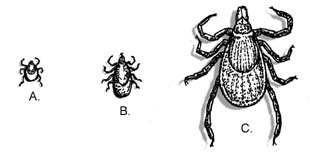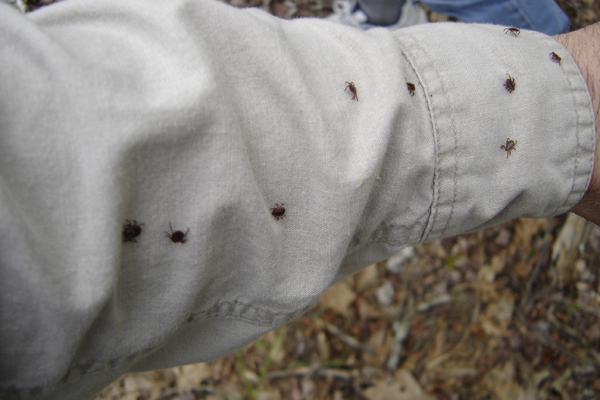Ticks in Nova Scotia
Widespread in the Eastern US. In Canada, it has been collected in Ontario, Quebec, and all Atlantic provinces.
In Image – Top: nymph, Blacklegged ticks. Bottom: dog ticks.
Lyme disease is a bacterial infection transmitted from an infected Blacklegged tick (aka Deer Tick). It can only transmit the bacteria after it has been attached to the skin (feeding on blood) for about 24 hours. It can be prevented by avoiding Blacklegged tick bites, and is treatable with antibiotics.
Widespread in the Eastern US. In Canada, it has been collected in Ontario, Quebec, and all Atlantic provinces.

A. blacklegged tick larva. B. blacklegged tick nymph. C. blacklegged tick adult.Ticks cannot jump or fly. They live mostly on grass and shrubs. Ticks may attach themselves to animals or people that walk through the grass or brush past the shrubs.
In most cases, the first symptom of Lyme disease is a rash near the tick bite that may look like a bull’s eye target. The bite is often painless, so you may not even know that you have been bitten. The rash usually appears between 7 to 10 days after the bite, but the range is between 3 and 30 days. You may also develop flu-like symptoms, such as fever, headache, tiredness, stiff neck, soreness all over, and pain or swelling in the joints. These symptoms may appear in stages and may occur over a period of months.
Some tips to protect yourself while geocaching in the outdoors:
Cover as much of your skin as possible.
- Tuck your shirt into your pants
- Tuck your pant leg into your socks
- Wear enclosed shoes
Use DEET on exposed skin or outer clothing.
- Do not use DEET on children under 6 months
Check yourself after your walk.
- armpits, groin & scalp
- remove ticks from skin promptly and carefully using tweezers
Avoid tall grasses and shrubby areas, favourite habitats of ticks. Keep lawns mowed regularly.
Remove ticks as soon as you find them.
- Carefully grasp the tick with tweezers as close to the skin as possible.
- Gently and slowly pull the tick straight out. Do not jerk, twist, or squeeze it.
- Disinfect the site with soap and water, rubbing alcohol, or hydrogen peroxide to avoid other infections.
Note the date and location of the bite.
- Record the date and location of the tick bite.
- Contact your doctor promptly if a rash or flulike symptoms appear.

Drop off or mail ticks to your nearest Department of Natural Resources office or to the Museum of Natural History in Halifax. Place the tick in a clean, sturdy pill bottle or film canister. Add a damp tissue to keep the tick fresh. Firmly tape the lid shut. Include your name, telephone number, and details about when and where in the province the tick was found. For example, found after walking through Garden Lots cemetery, Lunenburg County, on June 12, 2006. Mail to: Museum of Natural History, 1747 Summer Street, Halifax, NS B3H 3A6
Sources:

